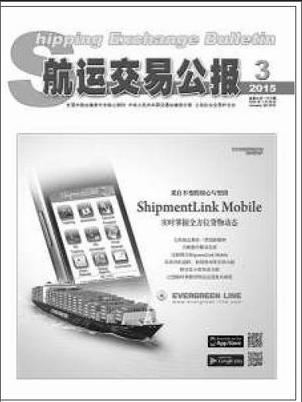Weekly Commentary on China Containerized Transportation
2015-02-02ZhuPengzhou
Zhu+Pengzhou

In the week ending Jan.9, China export box market sees demand slip slightly, leaving demand/supply condition in many services unimproved. Spot rate drops, only that in some services increases after box liners hiking, with the whole market slip. On Jan.9, China (Export) Containerized Freight Index (CCFI) issued by Shanghai Shipping Exchange (SSE) quote 1060.66 points, down by 0.4% from one week ago; while Shanghai (Export) Containerized Freight Index (SCFI) issued by SSE falls by 4.1% against last week to 1006.34 points.
In the Europe service, since that the whole market develop trend is unclear, the weak consumer confidence drags down the transport demand from improving. In the week ending Jan.9, the average slot utilization rate in the Shanghai Port keeps around 90%. In order to win more market shares, box liners begin to reduce freight rate. On Jan.9, the freight index in the China-Europe service quotes 1319.07 points, falling slightly by 0.8% from one week ago. In the Mediterranean service, transport demand stays firm, and the average slot utilization rate in the Shanghai Port stays in the range of 90%~95%, with fright rate on the similar level as that in the Europe service. On Jan.9, freight index in the China-Mediterranean service quotes 1440.65 points, up by 1.1% from one week ago. Furthermore, since Jan.1, most box liners in the Europe and Mediterranean services begin to collect low-sulfur surcharges.
In the North America service, as the increasing employment rate, the consumer confidence and actual consuming capability have an improvement, which boosts transport demand further. The average slot utilization rate in the USWC service keeps above 90%, with spot rate slip continuously. Transport demand in the USEC service is hot, where the average slot utilization rate hovers above 95%, with many even 100%. Spot rate keeps stable in general. On Jan.9, freight rate in the Shanghai-USWC service (covering seaborne surcharges) quote USD1930/FEU, falling by 6.2% against one week ago, while freight rate in the Shanghai-USEC service quote USEC USD4500/FEU, almost in line with that in one week ago. Furthermore, most box liners start to collect low-sulfur surcharges after Jan.1.
In the Australia service, the whole transport demand is still weak. Under the support of capacity limit measures, the average slot utilization rate at the Shanghai Port rises slightly to be 85% about. In order to hike freight rate level, part of box liners start to carry out freight rate increase plan. Nevertheless, because of the different attitude towards the timetable of hiking freight rate, booking rate this week arises slightly. On Jan.9, freight rate in the Shanghai-Australia service (covering seaborne surcharges) quote USD650 per TEU, up by 5.9% against last week.endprint
In the South America service, impacted by the local weak demand, transport demand stays on the unimproved condition. However, the too low freight rate forces box liners to push freight rate increase plan, causing booking rate in the spot rate rebounding largely. On Jan.9, freight rate in the Shanghai-South America service (covering seaborne surcharges) quote USD1206 per TEU, surging by 40.4% from one week ago. Transport demand is not improved in the Japan service, where the average slot utilization rate keeps at around 50%, with spot rate stable. On Jan.9, freight index in the China-Japan service quotes 648.92 points.
(Please contact the Information Dept of SSE for more details.)
SHIPPING EXCHANGE
BULLETIN
TOTAL EDITION: 916
20/1/2015
CONTENT FOR THIS WEEK
?LNG Market Would Slip Following Crude Oil in 2015
?DVB Bank Multiples Shipping Credit Portfolio
?Orient Intl. Logistic Holding Strives to Supply the Top
Comprehensive Logistics Service
?COSCOL Covers Special Vessels
?Shipping Companies Expect VOA to Be carried out
Disunity
?Ship Brokers Industry Experiences shufflingendprint
